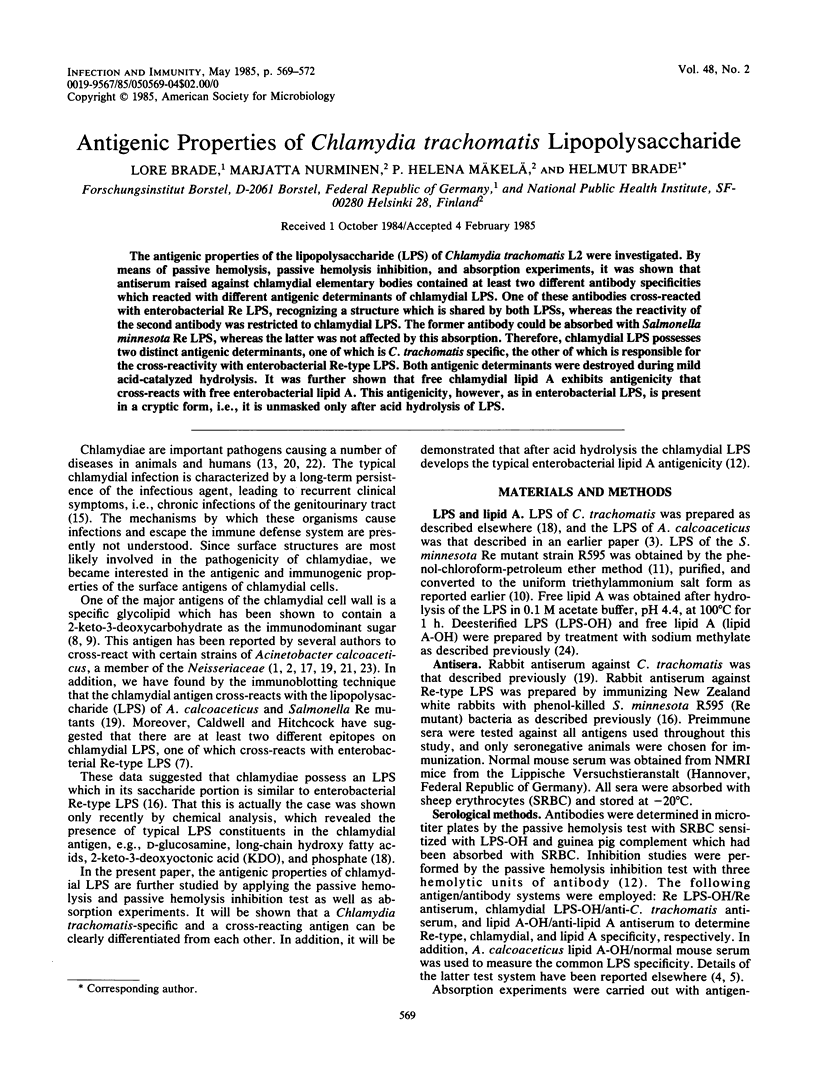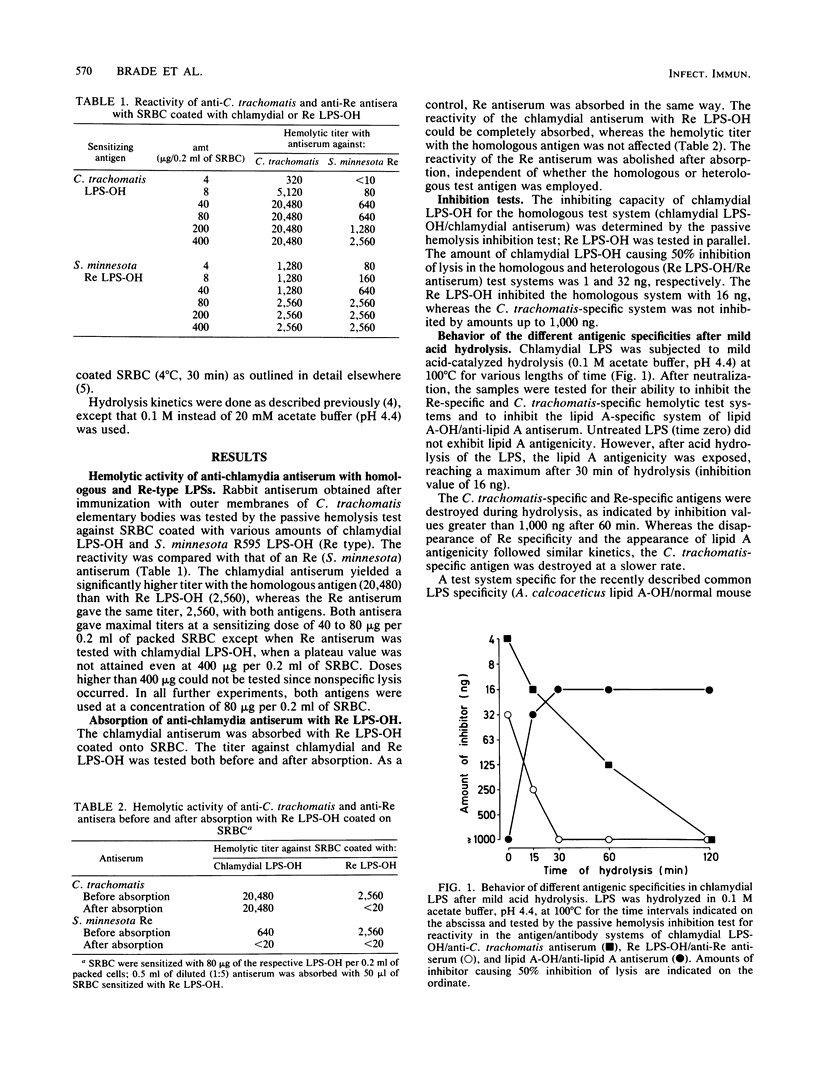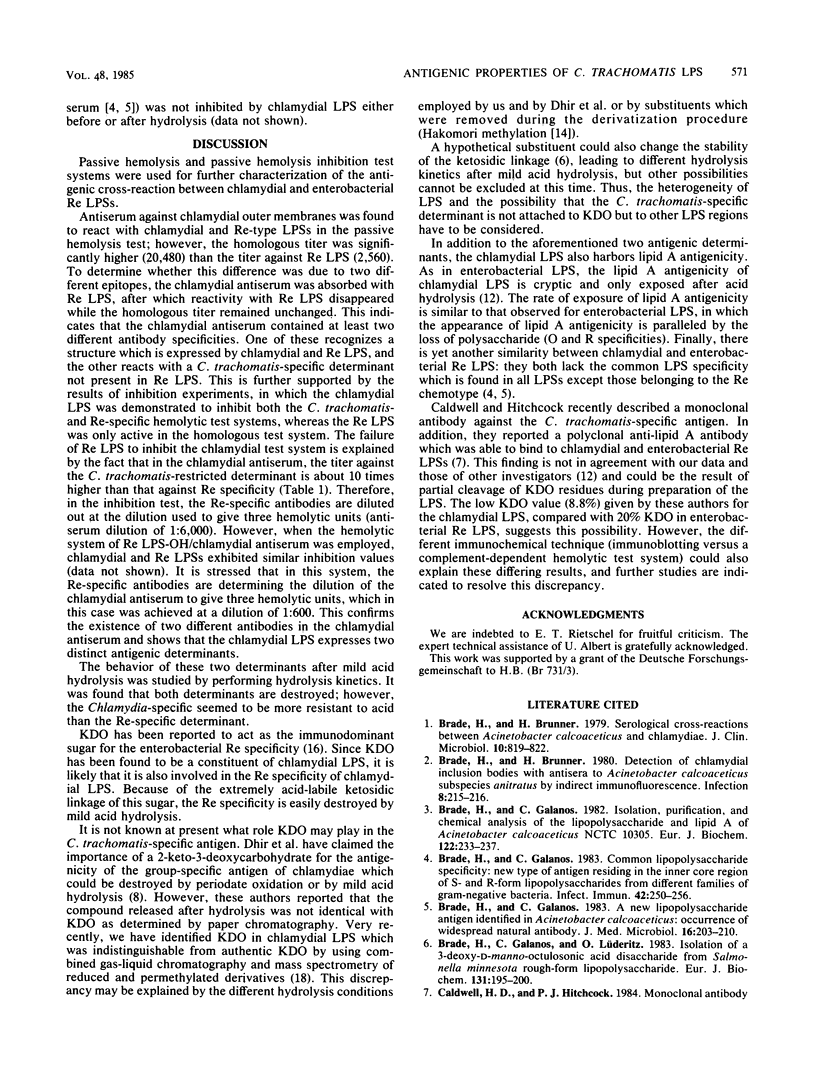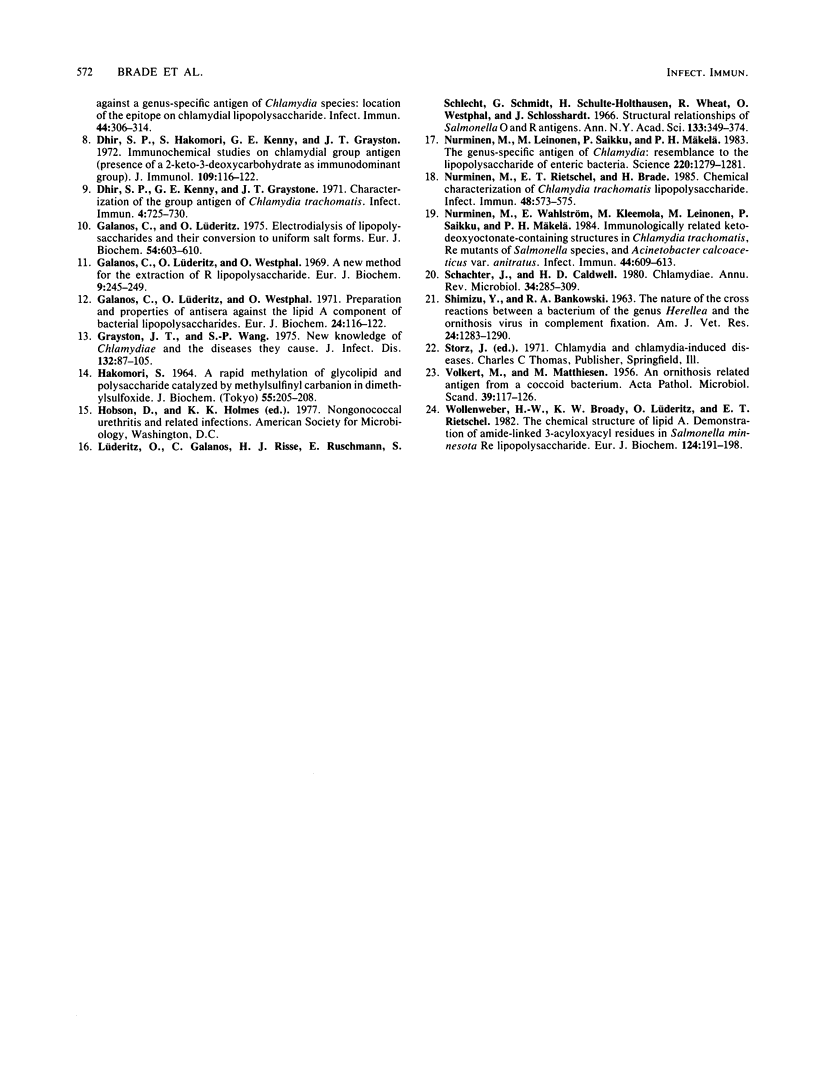Abstract
The antigenic properties of the lipopolysaccharide (LPS) of Chlamydia trachomatis L2 were investigated. By means of passive hemolysis, passive hemolysis inhibition, and absorption experiments, it was shown that antiserum raised against chlamydial elementary bodies contained at least two different antibody specificities which reacted with different antigenic determinants of chlamydial LPS. One of these antibodies cross-reacted with enterobacterial Re LPS, recognizing a structure which is shared by both LPSs, whereas the reactivity of the second antibody was restricted to chlamydial LPS. The former antibody could be absorbed with Salmonella minnesota Re LPS, whereas the latter was not affected by this absorption. Therefore, chlamydial LPS possesses two distinct antigenic determinants, one of which is C. trachomatis specific, the other of which is responsible for the cross-reactivity with enterobacterial Re-type LPS. Both antigenic determinants were destroyed during mild acid-catalyzed hydrolysis. It was further shown that free chlamydial lipid A exhibits antigenicity that cross-reacts with free enterobacterial lipid A. This antigenicity, however, as in enterobacterial LPS, is present in a cryptic form, i.e., it is unmasked only after acid hydrolysis of LPS.
Full text
PDF



Selected References
These references are in PubMed. This may not be the complete list of references from this article.
- Brade H., Brunner H. Serological cross-reactions between Acinetobacter calcoaceticus and chlamydiae. J Clin Microbiol. 1979 Dec;10(6):819–822. doi: 10.1128/jcm.10.6.819-822.1979. [DOI] [PMC free article] [PubMed] [Google Scholar]
- Brade H., Galanos C. A new lipopolysaccharide antigen identified in Acinetobacter calcoaceticus: occurrence of widespread natural antibody. J Med Microbiol. 1983 May;16(2):203–210. doi: 10.1099/00222615-16-2-203. [DOI] [PubMed] [Google Scholar]
- Brade H., Galanos C. Common lipopolysaccharide specificity: new type of antigen residing in the inner core region of S- and R-form lipopolysaccharides from different families of gram-negative bacteria. Infect Immun. 1983 Oct;42(1):250–256. doi: 10.1128/iai.42.1.250-256.1983. [DOI] [PMC free article] [PubMed] [Google Scholar]
- Brade H., Galanos C. Isolation, purification, and chemical analysis of the lipopolysaccharide and lipid A of Acinetobacter calcoaceticus NCTC 10305. Eur J Biochem. 1982 Feb;122(2):233–237. doi: 10.1111/j.1432-1033.1982.tb05871.x. [DOI] [PubMed] [Google Scholar]
- Brade H., Galanos C., Lüderitz O. Differential determination of the 3-Deoxy-D-mannooctulosonic acid residues in lipopolysaccharides of Salmonella minnesota rough mutants. Eur J Biochem. 1983 Mar 1;131(1):195–200. doi: 10.1111/j.1432-1033.1983.tb07249.x. [DOI] [PubMed] [Google Scholar]
- Dhir S. P., Hakomori S., Kenny G. E., Grayston J. T. Immunochemical studies on chlamydial group antigen (presence of a 2-keto-3-deoxycarbohydrate as immunodominant group). J Immunol. 1972 Jul;109(1):116–122. [PubMed] [Google Scholar]
- Dhir S. P., Kenny G. E., Grayston J. T. Characterization of the group antigen of Chlamydia trachomatis. Infect Immun. 1971 Dec;4(6):725–730. doi: 10.1128/iai.4.6.725-730.1971. [DOI] [PMC free article] [PubMed] [Google Scholar]
- Galanos C., Lüderitz O. Electrodialysis of lipopolysaccharides and their conversion to uniform salt forms. Eur J Biochem. 1975 Jun;54(2):603–610. doi: 10.1111/j.1432-1033.1975.tb04172.x. [DOI] [PubMed] [Google Scholar]
- Galanos C., Lüderitz O., Westphal O. A new method for the extraction of R lipopolysaccharides. Eur J Biochem. 1969 Jun;9(2):245–249. doi: 10.1111/j.1432-1033.1969.tb00601.x. [DOI] [PubMed] [Google Scholar]
- Galanos C., Lüderitz O., Westphal O. Preparation and properties of antisera against the lipid-A component of bacterial lipopolysaccharides. Eur J Biochem. 1971 Dec 22;24(1):116–122. doi: 10.1111/j.1432-1033.1971.tb19661.x. [DOI] [PubMed] [Google Scholar]
- Grayston J. T., Wang S. New knowledge of chlamydiae and the diseases they cause. J Infect Dis. 1975 Jul;132(1):87–105. doi: 10.1093/infdis/132.1.87. [DOI] [PubMed] [Google Scholar]
- HAKOMORI S. A RAPID PERMETHYLATION OF GLYCOLIPID, AND POLYSACCHARIDE CATALYZED BY METHYLSULFINYL CARBANION IN DIMETHYL SULFOXIDE. J Biochem. 1964 Feb;55:205–208. [PubMed] [Google Scholar]
- Lüderitz O., Galanos C., Risse H. J., Ruschmann E., Schlecht S., Schmidt G., Schulte-Holthausen H., Wheat R., Westphal O., Schlosshardt J. Structural relationship of Salmonella O and R antigens. Ann N Y Acad Sci. 1966 Jun 30;133(2):349–374. doi: 10.1111/j.1749-6632.1966.tb52376.x. [DOI] [PubMed] [Google Scholar]
- MATTHIESEN M., VOLKERT M. An ornithosis related antigen from a coccoid bacterium. Acta Pathol Microbiol Scand. 1956;39(2):117–126. doi: 10.1111/j.1699-0463.1956.tb03383.x. [DOI] [PubMed] [Google Scholar]
- Nurminen M., Leinonen M., Saikku P., Mäkelä P. H. The genus-specific antigen of Chlamydia: resemblance to the lipopolysaccharide of enteric bacteria. Science. 1983 Jun 17;220(4603):1279–1281. doi: 10.1126/science.6344216. [DOI] [PubMed] [Google Scholar]
- Nurminen M., Rietschel E. T., Brade H. Chemical characterization of Chlamydia trachomatis lipopolysaccharide. Infect Immun. 1985 May;48(2):573–575. doi: 10.1128/iai.48.2.573-575.1985. [DOI] [PMC free article] [PubMed] [Google Scholar]
- Nurminen M., Wahlström E., Kleemola M., Leinonen M., Saikku P., Mäkelä P. H. Immunologically related ketodeoxyoctonate-containing structures in Chlamydia trachomatis, Re mutants of Salmonella species, and Acinetobacter calcoaceticus var. anitratus. Infect Immun. 1984 Jun;44(3):609–613. doi: 10.1128/iai.44.3.609-613.1984. [DOI] [PMC free article] [PubMed] [Google Scholar]
- SHIMIZU Y., BANKOWSKI R. A. THE NATURE OF THE CROSS REACTIONS BETWEEN A BACTERIUM OF THE GENUS HERELLEA AND THE ORNITHOSIS VIRUS IN COMPLEMENT FIXATION. Am J Vet Res. 1963 Nov;24:1283–1290. [PubMed] [Google Scholar]
- Schachter J., Caldwell H. D. Chlamydiae. Annu Rev Microbiol. 1980;34:285–309. doi: 10.1146/annurev.mi.34.100180.001441. [DOI] [PubMed] [Google Scholar]
- Wollenweber H. W., Broady K. W., Lüderitz O., Rietschel E. T. The chemical structure of lipid A. Demonstration of amide-linked 3-acyloxyacyl residues in Salmonella minnesota Re lipopolysaccharide. Eur J Biochem. 1982 May;124(1):191–198. doi: 10.1111/j.1432-1033.1982.tb05924.x. [DOI] [PubMed] [Google Scholar]


